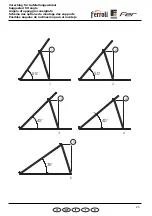
14
Betriebsempfehlungen
Operating tips
Consigli per la messa in funzione
Recommandations d’emploi
Recomendaciones para el funcionamiento
Flushing and filling
For safety reasons, you should only fill the collectors when there is no direct irradiation from the sun (or cover the
collectors). Especially in regions exposed to frost, for flat plate collectors you should use a mixture of (FS) antifreeze
with water (40% antifreeze).
Attention:
Antifreeze must be mixed with water before filling!
Recommended antifreeze for flat plate collectors: TYFOCOR-L
Note:
40% proportion of antifreeze - freezing point: -22° C/solidification point: -26° C
50% proportion of antifreeze - freezing point: -32° C/solidification point: -44° C
It may not be possible to completely empty collectors once they have been filled. For this reason, collectors exposed
to frost should only be filled with a water/antifreeze mixture, also for pressure and function tests. Alternatively, the
pressure test can also be carried out using compressed air and leak detection spray.
Installing the temperature sensor
The temperature sensor should be installed in the sensor sleeve nearest to the collector array flow. To ensure
optimal contact between the sensor and the surrounding environment, the gap between the sensor sleeve and the
sensor element should be filled with a suitable conducting compound. All materials used for installing temperature
sensors (sensor element, conducting compound, cables, sealing and insulating materials) must be suitably
temperature resistant (up to 250° C).
Operating pressure
The maximum operating pressure is 10 bar.
Bleeding
The system must be bled:
- when commissioning the system (after filling the collectors)
- 4 weeks after commissioning
- when necessary, e.g. if there are malfunctions
Warning:
Risk of scalding due to steam and hot heat transfer fluid!
Only operate the bleeding valve if the temperature of the heat transfer fluid is
< 60° C
.
When bleeding the system, the collectors must not be hot! Cover the collectors and, if possible, bleed the system
in the morning.
Check heat transfer fluid
The heat transfer fluid must be checked every two years with regard to its antifreeze and pH value.
- Check antifreeze using antifreeze tester and replace or refill if necessary!
Target value is ca. - 25° C and - 30° C depending on climatic conditions.
- Check pH value with a pH indicator rod (target value approx. pH 7.5):
If the limit pH value is less than
d
pH 7, replace the heat transfer fluid.
Maintenance of the collector
The collector or the collector array must be inspected visually, once a year, for any damage, leaks and
contamination.
Additional recommendations on operation and maintenance can be found in the supplier's general documentation
and instructions on commissioning and maintenance.















































